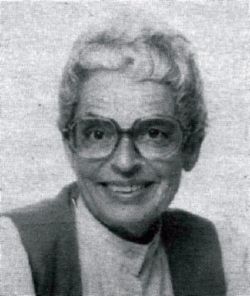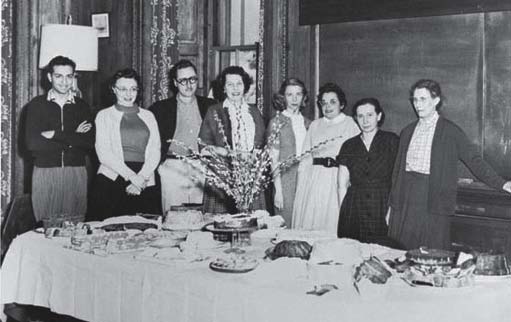| Publications: SRL: Unsung Heroines |
November/December 2006
Ruth B. Simon

▲ Ruth B. Simon, circa 1978
Following the 1999 death of physician John L. Simon, a paid obituary in the New York Times described his professional accomplishments. It neglected to mention, however, that he may have unwittingly provided the impetus for his first wife, Ruth B. Simon, to launch a trail-blazing career as a researcher in seismology.
Ruth took her first job in seismology at Lamont Geological Observatory (known today as Lamont-Doherty Earth Observatory) in the late 1950s—out of necessity, former colleagues recall, after she was divorced from John and left supporting two children. Simon joined the Seismological Society of America in 1957 and remained a member until 2003.
Simon’s job at Lamont involved reading the large volume of seismographic records that were collected on a daily basis from a diverse assortment of instruments, including Wood-Anderson, Benioff long- and short-period, and Press-Ewing seismometers. She also prepared the monthly seismic bulletin under the supervision of Frank Press. Simon came to the job with expertise in the interpretation of a different sort of wiggly line: she had experience interpreting electrocardiograms. Working from her desk in Lamont Hall, she read the records and made calculations to determine distance as well as Ms. Lynn Sykes, who arrived in 1960, recalls the excitement of this key era in seismology: In addition to Ruth, the small group also included Lee Alsop, who was working on records from the 1960 Chilean earthquake.
Sykes describes Simon as “no nonsense,” with no time for foolishness at work. However, he and others also offer warm recollections of visits to Simon’s home, which sat on a couple of acres in the then largely undeveloped town of New City in Rockland County, where Simon had a pair of woolly and wise lawnmowers—two sheep, by Sykes’s recollection named Socrates and Plato—who kept the grass trimmed.
Simon left Lamont in 1967 for the Colorado School of Mines (CSM), where she was hired as a research assistant and earned a master’s degree under the supervision of Paul Winston. Among her research projects was one supported by the National Science Foundation to look for correlations between seismicity and the activity level of insects. Although some looked askance at the project, it was one of the few experiments designed to rigorously test the longstanding notion that animals can sense impending earthquakes. As Simon wrote in a 1976 abstract: “The Chinese claim that animal-behavior observations aid in earthquake prediction. This claim should be scientifically tested.” She reported preliminary results of her experiments, which involved observations of cockroaches kept in pens near Hollister, Twin Lakes, and Pinyon Flat Observatory, at the 1976 American Geophysical Union meeting. The full results of this study never were published, however; it is not clear if the experiments ever yielded good data. Simon did publish a handful of other articles, including a report on the seismicity of Colorado in Science in 1969 and a comment in BSSA in 1968. She also served as secretary for the Eastern Section of SSA in 1963–64.
Following her time at CSM, Simon worked at the U.S. Geological Survey office in Golden, Colorado, where she investigated a number of historic earthquakes in Colorado and elsewhere. During this time Gil Bollinger enlisted her to make independent intensity assignments of nearly 1,000 accounts of the 1886 Charleston, South Carolina, earthquake. By the account of former colleague Jim Dewey, Simon’s tenure at the USGS was shadowed by a FBI investigation into reports that she had been a member of the Communist Party. (Then and now, employees of the government make the same oath as the president of the United States, swearing to preserve, protect, and defend the Constitution; they also have to state that they have never been a member of organizations that seek to overthrow the government.) Although the investigation cleared her, Dewey suspects it was one of the factors that prompted Simon to leave the USGS. In 1978 she joined the staff of Woodward-Clyde consultants in San Francisco, working under the supervision of Don Tocher. Her initial responsibilities included working on seismicity studies for Consolidated Edison.
Simon’s most enduring written contribution is her manual for the interpretation of seismograms. She published an initial, slim version of the manual when she was at CSM. In a 1970 review in BSSA, Dean S. Carder described it as “an excellent piece of work… a must for seismologists, amateur and professional.” In the preface she wrote that the manual had been inspired by Inge Lehman’s 1954 manual, Characteristic Earthquake Records, published by the Geodetic Institute of Denmark. Simon and Lehman had in fact become close friends during an extended visit that Lehman made to Lamont in the early 1960s.
At Woodward-Clyde, Simon found a highly capable editor in the person of Janet Cluff, who helped her prepare and find a publisher for an expanded version of the earlier manual, Earthquake Interpretations: A Manual for Reading Seismograms. This manual, published in 1981 by William Kaufman, Inc., went on to become a valuable resource for network analysts.
Cluff recalls Simon’s struggles with debilitating arthritis, which left her “older than her years.” Lloyd Cluff, Janet’s husband, recounts Simon’s routine of swimming for a full hour every morning to keep her joints loose enough so that she was able to walk.
Ruth Simon was born in 1917 and was living in Tucson, Arizona, when her SSA membership lapsed in 2004. A search of Social Security and other available records failed to unearth a current address or any record of her death, which leaves this brief biography mute on her current whereabouts. If you know or knew Ruth, the SSA office or I would be happy to hear from you.![]()
Susan Hough
hough [at] usgs.gov
with contributions from
Susan Newman and Bill Rinehart

▲ Ruth Simon (third from right) at going-away party for Inge Lehmann (far right). Photo taken at Lamont Hall circa 1954. Reproduced courtesy of Lamont-Doherty Earth Observatory.
[Back]
Posted: 02 November 2006

